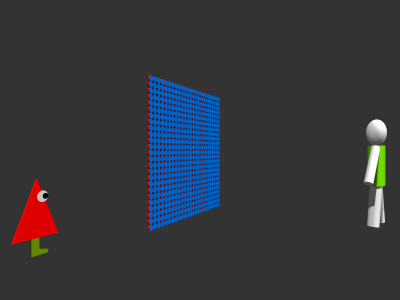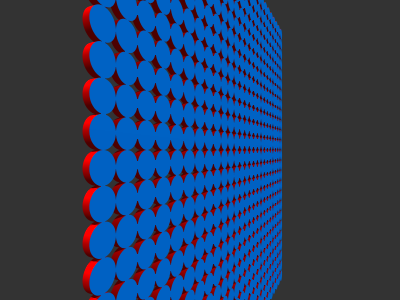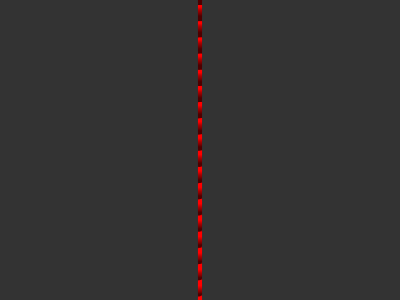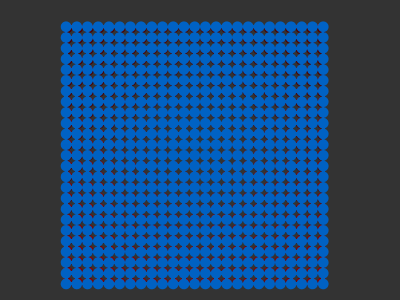4Dspace wrote:[...] If you used analytic geometry instead of lame analogies, you would see very quickly that in 4D, a ray from a POV outside the cube cuts through the middle of the cube, thus allowing to see the "inner side" of its far faces. The front faces are seen from outside.
Hooray! Let's do some analytical geometry! Those are always fun.
Let the cube's corners be defined by the points (±1,±1,±1,0). Its faces, therefore, are the following six squares:
1) the one with the corners (-1,1,1,0), (1,1,1,0), (1,-1,1,0), (-1,-1,1,0). This face is perpendicular to the vector (0,0,1,0).
2) the one with the corners (-1,1,-1,0), (1,1,-1,0), (1,-1,-1,0), (-1,-1,-1,0). This face is perpendicular to the vector (0,0,-1,0).
3) the one with the corners (-1,1,1,0), (-1,1,-1,0), (-1,-1,-1,0), (-1,-1,1,0). This face is perpendicular to the vector (-1,0,0,0).
4) the one with the corners (1,1,1,0), (1,1,-1,0), (1,-1,-1,0), (1,-1,1,0). This face is perpendicular to the vector (1,0,0,0).
5) the one with the corners (-1,1,1,0), (-1,1,-1,0), (1,1,-1,0), (1,1,1,0). This face is perpendicular to the vector (0,1,0,0).
6) the one with the corners (-1,-1,1,0), (-1,-1,-1,0), (1,-1,-1,0), (1,-1,1,0). This face is perpendicular the vector (0,-1,0,0).
Since all the corners of the cube have the last coordinate 0, it follows that the inside of the cube must also have the last coordinate 0. This makes sense, because the cube lies in the hyperplane where the 4th coordinate is zero.
Now let's trace some lines of sight! First, let's put our viewpoint at (0,0,0,5), and orient ourselves so that we're looking at (0,0,0,0) directly. So the vector from our viewpoint to (0,0,0,0) is (0,0,0,-5). Let's assume that our field of vision is 45° (a reasonable assumption, I hope, unless we have tunnel vision. Which we don't.). So that means any line passes through our viewpoint (0,0,0,5) and makes an angle of less than 45° with (0,0,0,-5) represents a line of sight from our viewpoint to what we can see.
So. Let's consider the line:
L1 = (0,0,0,5) + k*(0,0,1,-5), where k is free to vary from 0 to infinity.
When k=0, the line crosses (0,0,0,5), which is our viewpoint. Now let's make sure it actually represents a valid line-of-sight. The dot product of the direction vector, (0,0,1,-5), with (0,0,0,-5) is 25. So using the definition of dot product A dot B = |A|*|B|*cos T, we have:
|A|*|B|*cos T = 25
Since the magnitude of the vector (0,0,1,-5) is |A|=sqrt(26), and the magnitude of the vector (0,0,0,-5) is |B|=5, we plug in these numbers and do a little algebra to get:
cos T = 25 / (sqrt(26) * 5)
So we use our calculator to solve for T by taking the arccos on both sides of the equation, and we get T = approximately 11.3°, which is less than 45°. So this line represents a valid line of sight.
Now let's take a closer look at it. When k<1, the last coordinate is always positive. Since the cube lies in the hyperplane where the last coordinate is always 0, this line doesn't intersect the cube when k<1. Luckily, when k=1, the line passes through (0,0,1,0) -- the last coordinate is zero, so this is where the line crosses our 3D hyperplane. And it so happens that (0,0,1,0) lies on face #1 of the cube. So we have found a line of sight from (0,0,0,5) that crosses one face of the cube. Furthermore, since the line only crosses the 3D hyperplane when k=1, it doesn't intersect the rest of the cube. The only intersection is (0,0,1,0).
Now let's look at L2 = (0,0,0,5) + k*(0,0,-1,-5), again with k free to vary from 0 to infinity.
If we take the dot product of (0,0,-1,-5) with (0,0,0,-5), we will see that it's equal to 25, just like with L1. The magnitude of the vector (0,0,-1,-5) is also sqrt(26), so taking out our calculator and solving for the angle again, we find that it's also 11.3°, which lies within our field of vision.
So let's take a closer look at L2. When k=0, it passes through our viewpoint (0,0,0,5). When k<1, the last coordinate is, again, positive. When k=1, then the last coordinate is zero, and that's where it intersects our 3D hyperplane. Plugging in k to the equation of the line, we find that the intersection is (0,0,-1,0), which happens to lie on face #2. Again, since the line only crosses the 3D hyperplane at k=1, this is the only place where it intersects with the cube.
Now, you'll note that face #1 is directly opposite face #2 (you can check this from the coordinates of the cube). But... wait a minute, how is it possible to see two
opposite faces of the cube at the same time?! Whoa, this is weird. Let's check out some other lines to see what's going on. Let's look at the line:
L3 = (0,0,0,5) + k*(0,0,0,-1)
Again, we verify that this line lies within our field of vision, by computing the dot product of (0,0,0,-1) with (0,0,0,-5), plugging into the equation for dot product, and solving for the angle. This time, the angle turns out to be 0°. (Unsurprisingly, since this is the line directly at the center of our field of vision.) So let's see. When k=0, the line passes through (0,0,0,5). OK. When k<1, the last coordinate is positive, so it doesn't intersect the cube. When k=0, the line passes through (0,0,0,0). Aha! This is where it intersects the 3D hyperplane. But wait, (0,0,0,0) lies inside the cube, so that means L3 intersects the cube at (0,0,0,0).
Hold on a second here!! When k<1, the last coordinate is positive, and when k>1, the last coordinate is negative. So k=1 is the only place where the line crosses the 3D hyperplane. That means the middle of the cube is unobscured?! So we can see the middle of the cube from (0,0,0,5)
without passing through any other part of the cube. Something strange is going on here. Let's look at more lines to see what else is happening.
To save space (since this post is already growing too long) let's consider the next two lines at the same time:
L4 = (0,0,0,5) + k*(-1,0,0,-5)
L5 = (0,0,0,5) + k*(1,0,0,-5)
I'll leave it up to the reader to confirm that both (-1,0,0,-5) and (1,0,0,5) make an angle with (0,0,0,-5) that's less than 45°. So they both lie in our field of vision. Again, as before, when k=0, both lines pass through the viewpoint (0,0,0,5). When k<1, the last coordinates are positive, so they don't intersect the 3D hyperplane that the cube sits in. When k=1, they both pass through the 3D hyperplane. L4 passes through at (-1,0,0,0) and L5 passes through at (1,0,0,0). Since the last coordinate is non-zero for all other values of k, that means these are the only intersections between each respective line and the 3D hyperplane.
Hmm. This is certainly odd! (-1,0,0,0) lies on face #3 of the cube, and (1,0,0,0) lies on face #4. But if you examine the coordinates of the cube, you'll see that face #3 and face #4 are also opposite each other. Crazy, huh? Apparently from (0,0,0,5) we can see not just
one pair of opposite faces, but
two!
What about the next two lines?
L6 = (0,0,0,5) + k*(0,1,0,-5)
L7 = (0,0,0,5) + k*(0,-1,0,-5)
I won't repeat the computations here -- by now it's clear how to do it. The angles that these two lines make with (0,0,0,-5) are both <45°, so they are also in our field of vision. When k=0, they cross the viewpoint (0,0,0,5). When k<1, the last coordinates are positive, and when k>1 the last coordinates are negative. When k=0, the last coordinate is zero. So that's where each respective line crosses the 3D hyperplane. A little algebra shows that the intersections are (0,1,0,0) and (0,-1,0,0), respectively. Checking the coordinates of our cube again, we see that (0,1,0,0) lies on face #5, and (0,-1,0,0) lies on face #6. Again, since the only time the last coordinate is zero is when k=1, that means these intersections are not obscured by anything else; there is an unobscured line of sight from (0,0,0,5) to (0,1,0,0), and also from (0,0,0,5) to (0,-1,0,0).
Huh. So now we have a situation here.
All six faces of the cube are unobscured!! Not only so, it seems that the middle of the cube is unobscured, too. And there is no secret transparency of the cube's faces that allow us to see all 6 faces at once, either -- the lines of sight we traced aren't even in the 3D hyperplane until they intersect the cube at points on all six faces. The cube is solid and opaque, and yet we can still see all 6 faces
and its middle simultaneously. Neither is there any omnipresence; all our computations started from a single viewpoint (0,0,0,5).
I tell ya, this analytical geometry thing is
weird. All we did was to follow basic geometric computations, and we end up with such strange conclusions. No wonder people think math is hard.

 ? Maybe then I can understand better what you wrote about the 4Ders that can't see some edges of a cube (and/or a hypercube?) and how this goes together with quickfurs model of 4D seeing, where they can see every little bit at once. Somehow it sounds both true but somehow also a little contradictory, in any case, quite difficult to comprehend.
? Maybe then I can understand better what you wrote about the 4Ders that can't see some edges of a cube (and/or a hypercube?) and how this goes together with quickfurs model of 4D seeing, where they can see every little bit at once. Somehow it sounds both true but somehow also a little contradictory, in any case, quite difficult to comprehend.










 .
.
 And there's a story? Heh. It was just a story idea. I was just thinking more of an after-the-fact story that presumes the reader already has a little understanding of 4D, that starts out sounding like it's just another version of Abbott's "Flatland", when suddenly it turns out to have been talking about a 4D being dreaming about a "flat" 3D world all along.
And there's a story? Heh. It was just a story idea. I was just thinking more of an after-the-fact story that presumes the reader already has a little understanding of 4D, that starts out sounding like it's just another version of Abbott's "Flatland", when suddenly it turns out to have been talking about a 4D being dreaming about a "flat" 3D world all along.







